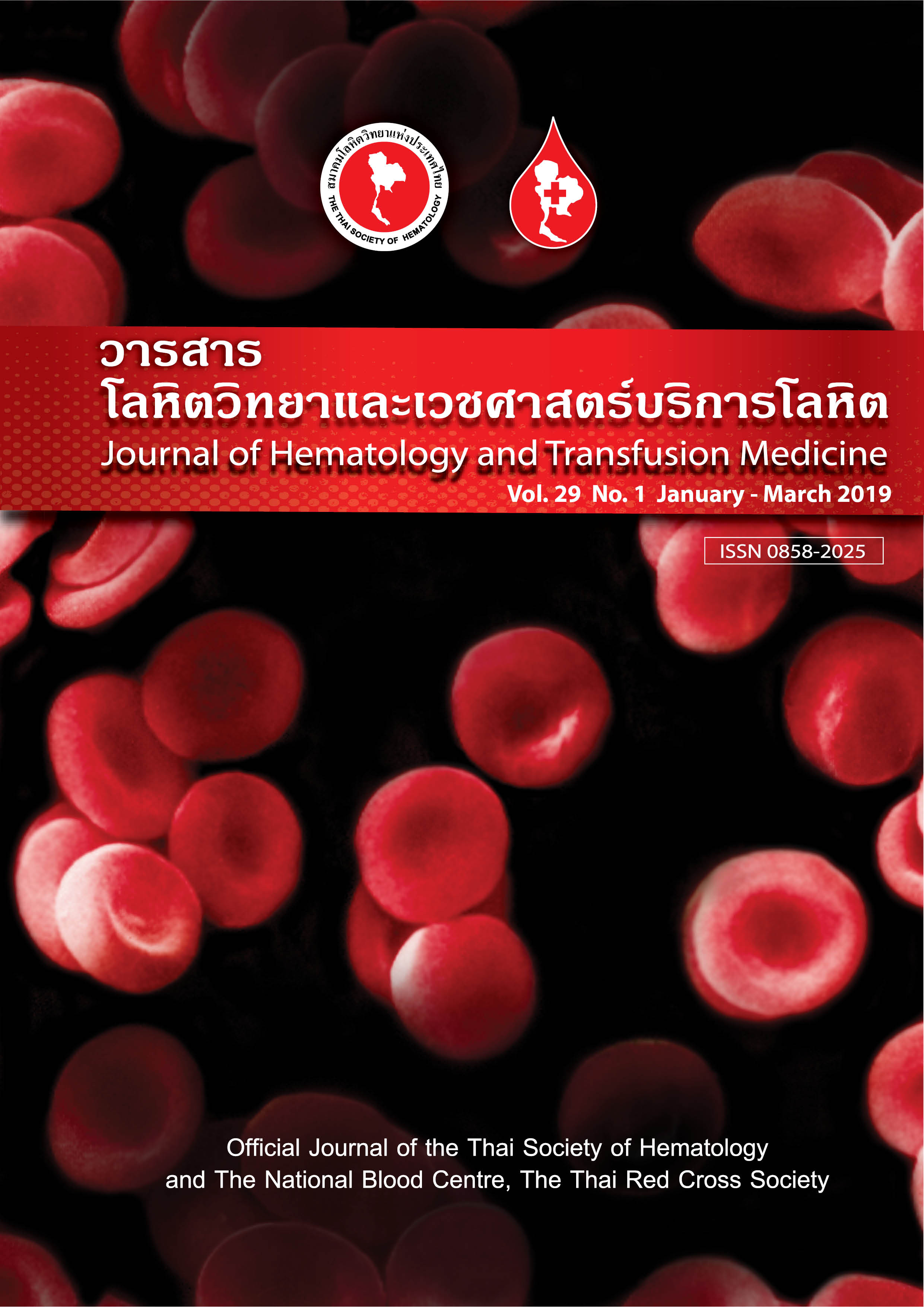การดูแลสุขภาพผู้บริจาคโลหิตเพื่อการบริจาคที่ยั่งยืน
Keywords:
Donor retention, First time donors, Sustainable, การคงไว้ซึ่งผู้บริจาคโลหิต, ผู้บริจาคโลหิตครั้งแรก, การบริจาคที่ยั่งยืนAbstract
บทคัดย่อ
ความเป็นมา ในสถิติของศูนย์บริการโลหิตแห่งชาติปี พ.ศ. 2555 มีเพียงร้อยละ 18 ของผู้บริจาคโลหิตทั้งหมด ที่กลับมาบริจาคโลหิตครั้งที่ 2 ภายใน 1 ปี จากรายงานการศึกษาพฤติกรรมผู้บริจาคโลหิต พบว่าผู้บริจาคโลหิตที่บริจาคอย่างน้อย 2 ครั้งในปีแรก จะคงเป็นผู้บริจาคประจำต่อเนื่องตลอดไป วัตถุประสงค์ เพื่อเพิ่มจำนวนผู้บริจาคโลหิตที่กลับมาบริจาคครั้งที่ 2 ภายใน 1 ปี และเป็นผู้บริจาคประจำตลอดไป ด้วยการสร้างความประทับใจแก่ผู้บริจาคโลหิตครั้งแรก โดยการต้อนรับและดูแลอย่างดี รวมถึงให้ข้อมูลและความรู้ที่จำเป็น สำหรับการบริจาคโลหิต วิธีการศึกษา เก็บข้อมูลจากผู้บริจาคโลหิตครั้งแรกในศูนย์บริการโลหิตแห่งชาติ ระหว่างวันที่ 1 ตุลาคม ถึงวันที่ 30 ธันวาคม พ.ศ. 2557 ที่กลับมาบริจาคครั้งที่ 2 ในปี พ.ศ. 2558 ซึ่งผู้บริจาคโลหิตกลุ่มนี้ จะได้รับการลงทะเบียนและชี้บ่งผู้เข้าร่วมโครงการด้วยสัญลักษณ์ DR (donor retention) ตั้งแต่การบริจาคโลหิตครั้งแรก และเพิ่มการเก็บตัวอย่างโลหิตเพื่อตรวจ CBC (complete blood count) และ SF (serum ferritin) อธิบายผลการตรวจ เหตุผลและวิธีการรับประทานธาตุเหล็ก รวมถึงอาหารที่เหมาะสมและเพียงพอต่อการเพิ่มธาตุเหล็ก เมื่อครบกำหนดบริจาคครั้งที่ 2 จะทำการโทรศัพท์ติดตาม และตรวจสารเคมีในเลือด (blood chemistry) เพิ่มเติมเมื่อมาบริจาคครั้งที่ 2 เก็บข้อมูลการกลับมาบริจาคครั้งที่ 2 ภายใน 1 ปีนับจากวันบริจาคครั้งแรก ผลการศึกษา ผู้บริจาคโลหิตครั้งแรกเข้าร่วมโครงการ 1,944 ราย เป็นชาย 814 ราย (41.87%) หญิง 1,130 ราย (58.13%) กลับมาบริจาคครั้งที่ 2 ภายใน 1 ปี จำนวน 875 ราย (45.01%) เป็นชาย 364 ราย (41.60%) หญิง 511 ราย (58.40%) ผ่านเกณฑ์คัดกรองการบริจาคโลหิต 783 ราย (89.49%) เป็นชาย 329 ราย (42.02%) หญิง 454 ราย (57.98%) ไม่ผ่านเกณฑ์คัดกรองการบริจาคโลหิต 92 ราย (10.51%) เป็นชาย 35 ราย (38.04 %) หญิง 57 ราย (61.96%) สาเหตุเนื่องจากความเข้มโลหิตไม่ผ่านเกณฑ์ 36 ราย (39.13%) เป็นชาย 7 ราย (19.44%) หญิง 29 ราย (80.56%) และไม่ผ่านการคัดกรองสุขภาพ 56 ราย ( 60.87%) เป็นชาย 28 ราย (50.00%) หญิง 28 ราย (50.00%) เหตุผลมีผู้บริจาคต้องการตรวจสารเคมี 101ราย (11.54%) ส่วนที่เหลือไม่ต้องการตรวจ สรุป ผู้บริจาคโลหิตครั้งที่ 2 ภายใน 1 ปี มีจำนวนเพิ่มขึ้นเมื่อเทียบกับสถิติปี พ.ศ. 2557 (p=0.0504) ผู้บริจาคโลหิตที่กลับมาและไม่ผ่านเกณฑ์การคัดกรอง มีจำนวนน้อยกว่ากลุ่มผู้บริจาคโลหิตทั่วไป (p=0.01) แรงจูงใจเรื่องการให้ตรวจสารเคมีในเลือดมีผลเพียงร้อยละ 11.54 เนื่องจากมีสวัสดิการของตนรองรับอยู่แล้ว หรือบางรายอายุน้อยยังไม่เห็นความจำเป็นในการตรวจ การรณรงค์ให้ผู้บริจาคโลหิตครั้งแรกกลับมาบริจาคซ้ำอย่างน้อย 1 ครั้งภายใน 1 ปีเพิ่มขึ้น อาจต้องใช้กลวิธีต่างๆ ร่วมกันตามความเหมาะสม ประเด็นสำคัญคือ การสร้างความประทับใจ ประสบการณ์และความรู้สึกที่ดีต่อการบริจาคโลหิตครั้งแรก จะเป็นแรงดึงดูดใจให้ผู้บริจาคครั้งแรกกลับมาบริจาคซ้ำอีก และต่อเนื่องตลอดไป
Abstract:
Background: The National Blood Centre Annual Statistic 2012 indicated that there was only 18% of total blood donors who came back to donate again within the same year. It was observed that the one who donated at least twice in the first year would remain to be the regular blood donor for a long time. Objective: To attract the first time blood donors to come back again within one year and continue to be regular blood donors by using the donor care process to impress them by providing the hospitality and good care as well as providing necessary information and education. Materials and Methods: Allocate first time blood donors at The National Blood Centre from October 1 to December 30, 2014 who came back to donate again in 2015 into a list and identified them as DR (Donor Retention) in the first time blood donors. They went on blood donation according to routine procedure.In addition, the EDTA blood was collected and tested for CBC and serum ferritin level. The results of the test and the information on why and how to take the iron pills including the appropriate and sufficient nutrition to increase iron intake were given to them. All of them would receive telephone calls to come back for the second time donation. Blood chemistry testing in the next donation was also offered. The data for the second blood donation within one year was captured. Results: A total of 1944 first time donors in the study consisted of 814 (41.87%) males and 1130 (58.13%) females. Those who came for second donation were 875 (45%) donors consisted of 364 (41.60%) males and 511(58.40%) females. It was observed that 783 (89.49%) donors that passed the criteria consisted of 329 (42.02%) males and 454 (57.98%) females. A total of 92 (10.51%) donors who did not pass the criteria consisted of 35 (38.04%) males and 57 (61.96%) females.They were 36 (39.13%) which were 7 (19.44%) males and 29 (80.56%) females due to low Hb level. A total of 56 (60.87%) donors who did not pass the health screening consisted of 28 (50.0 %) males and 28 (50.00%) females. There were only 101 (11.54%) of them requested for blood chemistry test while the rest were not interested in blood testing. Conclusion: There was markedly increase for second donation within one year as compared to the previous year (A.D. 2014) data (p=0.05).The number of those who did not passed donor criteria was lower than the general donors (p=0.01). Only 11.54% of total donors requested for blood chemistry test. This may be covered by other health care programs and the young may be not yet concern. Therefore, promotion for second donation within one year may require various kinds of strategy. The most important issue is to create good impression, good experience at the first donation. This will attract first time donors to come to donate again and continue to be regular blood donors.
Downloads
References
1. Lee CK, Hong J, Hung ATF. An update of blood donor recruitment and retention in Hong Kong.
Asian J Transfus Sci. 2008;2:47-50.
2. Facts about donors blood facts and Statistics/American Red Cross. Available from
http://www.redcrossblood.org/learn-about-blood-facts searched on June 4, 2014.
3. Lourencon AF, Almeda RG, Ferreira O, Martinez EZ. Evaluation of the return rate of volunteer blood
donors. Rev Bras Hematol Hemoter. 2011;33:190-4.
4. Guo N, Wang J, Ness P,Yao F, Dong X, Bi X, et al. Analysis of Chinese donors’ return behavior.
Transfusion. 2011;51:523-30.
5. National Blood Centre, Thai Red Cross Society. Annual report. Bangkok: Chulalongkorn University
Printing House; 2012.
6. Phikulsod S, Chiewsilp D, Ongtilanont K, Bharkbhumpong T, Patanapongsak W. Donor care, the
change we need! Vox Sang. 2009; 97 (suppl.1):60. (abstract).
7. Sutthisakorn U, Wattananonsakul S, Chiewsilp D. A study of blood donation behavior of donors at the
National Blood Centre, the Thai Red Cross Socienty. J Hematol Transfus Med. 2014;3:251-259.
8. Schreiber GB, Sharma UK, Wright DJ, Glynn SA, Ownby HE, Tu Y, et al. First year donation patterns
predict long-term commitment for first-time donors. Vox Sang. 2005;88:114-21.
9. Phikulsod S, Chiewsilp P. Reformed donor care, the Thai Red Cross Society. J Hemtol Transfus Med.
2015;25:3-5.
10. Milman N, Sondergaard M. Iron stores in male blood donors evaluated by serum ferritin. Transfusion
1984;24:464-8.
11. National Blood Centre, Thai Red Cross Society. Annual report. Bangkok: Chulalongkorn University
Printing House; 2014.



